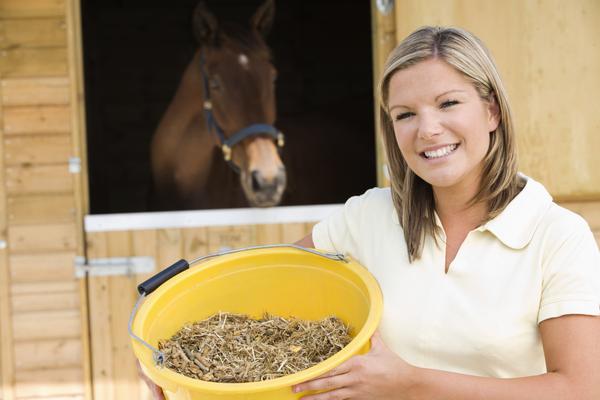While all horses have their unique horse feeding rhythms, it’s important to follow the same basic guidelines.
1. Plenty of Roughage
The digestive system of horses is best suited to extract the necessary nutrients from grassy stalks. A horse will eat one to two percent of his body weight in roughage every day. Stable bound horses do not graze much, but nibbling on hay kept in front of them during the day, while taking occasional breaks and short naps will help keep some roughage in constant motion through their systems.
2. Small and frequent feeds
If you include grain in their diet, it’s better to feed them multiple smaller meals rather than one large one. Small, frequent meals are more natural and promote better digestion for the horse.

3. Co-relate feed to the horse’s needs
- Every horse has different needs primarily based on size and the amount of work done by the horse. Heavier work load translate to more food and vice versa. As the amount of work done by the horse changes, make adjustments in food ration.
- Similarly an animal who grazes on good pasture for most part the day doesn’t need much hay, while stable bound horses or those without access to good pasture will need more hay.
- During seasonal changes like winter or drought, you may need to supplement pasture grazing with hay. The amount of hay can be adjusted or eliminated based on the availability of grass in the pasture.
- Start with the minimum quantity of grain and adjust it upward if necessary.
- Apples, carrots and other succulents help in adding moisture to the feed and add an element of interest for the horse
- It’s important to provide a constant supply of water. You can also water the horse before feeding to prevent undigested food from getting washed away.
- Leisure horses do not need additional feeds like concentrate feeds. They can suffice with a vitamin and mineral supplement. Always consult a vet for advice on such additional feeds.
- A little bit of effort will help you arrive at the right balance of pasture, hay, grain and supplements to meet a particular horse’s needs.
4. Accurate measurement and consistent feeding
Ensure the horse is fed the same quantity and quality of meal at each feed. Maintain a regular feeding pattern as horses prefer a regular routine.
5. Make Gradual Changes to Feed and Feed Schedules
Any increase or decrease to horse rations or introduction of a new feed should be gradual else it can lead to colic or founder. Always carry a supply of water and food when travelling with your horse.
6. Cleanliness and general hygiene
Clean feed and feeding utensils are very important. Horses are extremely fussy and can be easily dissuaded from eating. Equal care must be taken with regard to the general hygiene in the stable, horse box used for transporting the horse and the horse itself. This will ensure the horse remains healthy.
7. Feeding and Exercise
A full stomach puts pressure on the horse’s lungs and makes it difficult to breathe. Doing vigorous exercise is also very difficult. Similarly, ensure the horse has cooled down and his breathing is back to normal before feeding him after work or exercise.